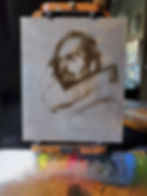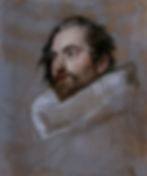Master Copy: Van Dyck's Magistrate of Brussels
- Sadie Valeri
- Nov 21, 2020
- 3 min read
Updated: Dec 20, 2020

Van Dyck painted a series of these portrait sketches in preparation for a major portrait commission which included the members of the Magistrate of Brussels. This particular study was only recently discovered, as it had been painted over to "finish" it. Now that it has been cleaned and restored, Van Dyck's hand in the brush strokes and color application have been revealed.
Purchase my Portrait Painting Course Browse my online art courses or become a member to access all the courses for an affordable monthly rate with personal instruction available.

Sketch of a Brussels Magistrate by Anthony van Dyck, 1634-5
I am not sure when the painting was obscured by an overpainting, but it looks to me like Sargent saw this original study, or one very similar, and used it as inspiration for a study he did:

Portrait of George Henschel, John Singer Sargent, 1889
Sargent's double-toned ground is similar to Van Dyck's. You can see the similarity especially if you compare the top left corner of both images, where not only can you see the red-brown tone underneath the gray tone, but you can also see Sargent has drawn the "edge" of the image with a line of umber paint, similar to the Van Dyck.
Unlike Van Dyck's head studies in this series, Sargent's head seems to be painted directly on the red-brown ground, and he uses the gray only in the background around the head. Sargent's paint application looks more opaque, and the top layer completely obscures any underpainting, both in the shadows and in the lights. Also, whether due to age or technique, Sargent's paint has more of the creamy, oily look we see in more modern paintings.

In contrast, the Van Dyck sketch, done more than 250 years before Sargent's, looks almost like a drawing done with a dry pigment. Van Dyck's paint strokes are often "broken" (separated from one another, leaving the previous layer visible between strokes) and the paint application is relatively thin, with previous layers of paint visible all the way down to the ground, particularly in the shadows, beard and hair. The light areas are more opaque and the darks remain transparent.

It's possible that removing the overpainting during restoration of the Van Dyck added to this dry, somewhat transparent effect of the paint, but even if so, it appears Sargent's technique was to blend and mix his wet paint colors together on the canvas, rather than laying down separate strokes.
So in my copy, I am emulating Van Dyck's process for building a painting in layers, using his method of paint application with short, dry strokes of broken color.
For the support, I toned an oil-primed linen panel with burnt umber, allowed it to dry, and then applied a gray layer of priming. The process of applying the gray layer inadvertently removed the umber tone from the top-most fibers of the linen, significantly lightening the whole ground. In later paintings I added alkyd medium to the first layer of prime, which made it dry faster and adhere better to the linen, so the exposed fibers remained dark red-brown, instead of light brown, like this panel.
I started with a sketch of the general values and shapes with raw umber paint.

Next I applied a thin layer of opaque paint in the light areas of the face and ear. I used lead white, raw sienna, and burnt umber for the flesh tones.

Palette Lead White Raw Sienna Burnt Sienna Burnt Umber Raw Umber Bone Black (also acts as a blue when mixed with white)
On top of that thin layer of wet paint, I completed the painting in another 2 passes of wet paint.

We are releasing a portrait video course soon based in this method, which includes a demonstration of how to apply this double-toned ground.
Purchase my Portrait Painting Course Browse my online art courses or become a member to access all the courses for an affordable monthly rate with personal instruction available.

